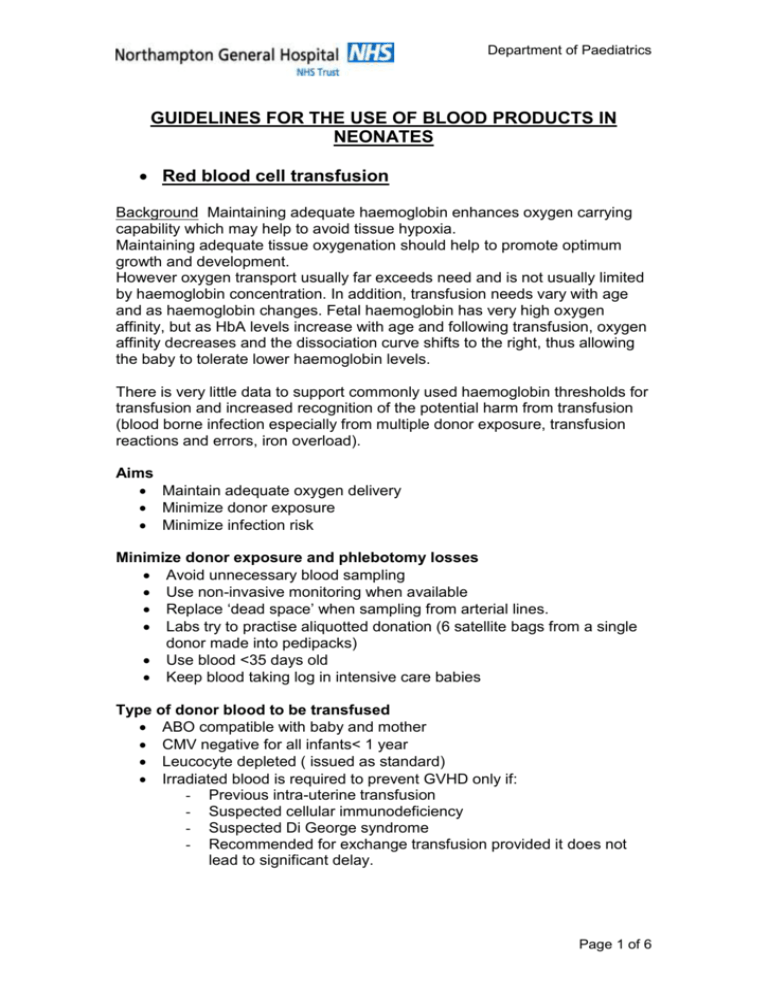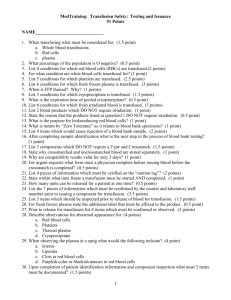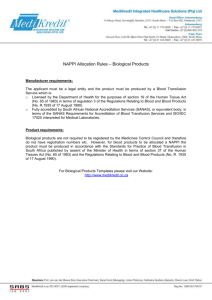guidelines for the use of blood products in neonates
advertisement

Department of Paediatrics GUIDELINES FOR THE USE OF BLOOD PRODUCTS IN NEONATES Red blood cell transfusion Background Maintaining adequate haemoglobin enhances oxygen carrying capability which may help to avoid tissue hypoxia. Maintaining adequate tissue oxygenation should help to promote optimum growth and development. However oxygen transport usually far exceeds need and is not usually limited by haemoglobin concentration. In addition, transfusion needs vary with age and as haemoglobin changes. Fetal haemoglobin has very high oxygen affinity, but as HbA levels increase with age and following transfusion, oxygen affinity decreases and the dissociation curve shifts to the right, thus allowing the baby to tolerate lower haemoglobin levels. There is very little data to support commonly used haemoglobin thresholds for transfusion and increased recognition of the potential harm from transfusion (blood borne infection especially from multiple donor exposure, transfusion reactions and errors, iron overload). Aims Maintain adequate oxygen delivery Minimize donor exposure Minimize infection risk Minimize donor exposure and phlebotomy losses Avoid unnecessary blood sampling Use non-invasive monitoring when available Replace ‘dead space’ when sampling from arterial lines. Labs try to practise aliquotted donation (6 satellite bags from a single donor made into pedipacks) Use blood <35 days old Keep blood taking log in intensive care babies Type of donor blood to be transfused ABO compatible with baby and mother CMV negative for all infants< 1 year Leucocyte depleted ( issued as standard) Irradiated blood is required to prevent GVHD only if: - Previous intra-uterine transfusion - Suspected cellular immunodeficiency - Suspected Di George syndrome - Recommended for exchange transfusion provided it does not lead to significant delay. Page 1 of 6 Indications for Transfusion Transfusion should be considered for the following babies but these are only guidelines, the decision to transfuse should be taken depending on the current clinical condition of the baby. Thresholds may be higher in the neonates with hypovolaemia, septic shock, or NEC or lower in the older, more stable babies. 1. Infants receiving intensive care or ventilated with O2 requirement. Acute blood loss 10% or cardiovascular compromise Cumulative loss of 10% in first week of life Hb <12g/dl 2. Oxygen dependent and/or continuous CPAP Symptomatic Hct < 35% (capillary) Hb <11g/dl (venous) 3. Weaning CPAP ( in air or low O₂ requirement <30%) Symptomatic Hct < 30% (capillary) Hb < 10g/dl (venous) 4. Stable infant & reticulocyte count <2.0% (100 x 10⁹/l) Symptomatic Hct < 20% (capillary) Hb< 7g/dl (venous) 5. Stable infant & reticulocyte count > 2.0% (100 x 10⁹/l) Avoid transfusion if possible Hct < 20% (capillary) Hb < 7 g/dl (venous) AND symptomatic Volume to be transfused Evidence suggests that transfusion with larger volumes leads to better rises in Hb and fewer overall transfusions. Calculate volume by Desired Hb (g/dl) – Actual Hb (g/dl) x weight (Kg) x 4 OR 20 mls/Kg Desired Hb is generally 14g/dl. For the extreme preterm or very unstable neonate especially in the first week of life transfusion volumes should be accurately tailored using the formula to avoid large fluid and blood pressure changes. Thereafter unless there is good reason to avoid large volumes it is advisable to use 20 mls/Kg, which is likely to be the higher volume. Frusemide The evidence to inform the use of frusemide is not strong, but it is our routine policy to give frusemide at a dose of 1mg/Kg mid way through a transfusion in order to minimize risk of fluid overload. In some circumstances e.g. hypovolaemia or hypotension, frusemide should be omitted. Discuss with SpR or consultant if unsure. Feeds There is concern that transfusion can be associated with the development of NEC. There is no good evidence for this. There are highly anecdotal accounts of well babies developing overwhelming NEC following ‘routine’ transfusion’ and there is some literature extrapolating from different situations (eg post in utero transfusion). Despite the lack of evidence we will continue to withhold feeds during transfusion in babies who are thought to be at high risk of NEC. Discuss with consultant or registrar. Timing of transfusion Intensive care, unwell or unstable babies should be transfused as soon as possible after the need is identified. In the stable baby who is having a more elective transfusion, it should be timed so that it finishes before 22.00 Pre transfusion testing Up to 4 months a sample from infant and mother for ABO and RhD group determination. 0.5 mls EDTA microtainer labelled with microtainer labels. The form must contain full clinical details, including gestation, previous transfusion history and the likelihood of need for multiple transfusions. Small volume transfusions can be given repeatedly over the first 4 months without further serological testing, provided there are no atypical maternal antibodies and the infant DAT is negative when first tested. Over 4 months new sample required Nb the heel prick screening now includes haemoglobinopathy testing. If a baby is to be transfused before this time, please complete a neonatal screening card before the baby is transfused. Liasing with the Lab Try to anticipate the need for transfusion early, especially in the intensive care babies. Try to notify the lab before midday if transfusion is needed OR is likely to be needed later in the day so that units can be brought over on routine transport. Documentation The date, time and amount of blood transfused MUST be written in the notes as well as the indication for transfusion. The sticker form the blood product unit will be stuck in the notes and the pack number should match the number on the request form. Transfer If a baby is being transferred and likely to need transfusion, check with the lab to arrange to transfer any usable satellite packs, to minimise donor exposure. Any blood products to be transferred with the baby must be packed by blood bank who will also liase with the receiving hospital blood bank. This applies to any blood products. PLATELET TRANSFUSION SEE PROTOCOL FOR INVESTIGATION AND MANAGEMENT OF THROMBOCYTOPAENIA Indications for Transfusion 1. Platelet count < 30 x 10⁹ Consider in all patients 2. Platelet count < 50 x 10⁹ < 1000 g and first week of life Clinically unstable ( eg fluctuating BP ,septic shock) Previous grade 3-4 IVH Minor bleeding ( petichiae or puncture site oozing) Concurrent coagulopathy Requires surgery or exchange transfusion 3. Platelet count < 100 x 10⁹ Active, significant bleeding (GI or pulmonary haemorrhage) Volume to be transfused 15mls /Kg over 30-60 minutes If red cell transfusion is also required, give platelets first Platelets to be transfused ABO and RhD compatible HPA compatible in suspected or proven alloimmune thrombocytopenia (commonly HPA-1a negative platelets required) In suspected cases of neonatal alloimmune thrombocytopenia (NAIT) Discuss with consultant haematologist prior to transfusion Platelets are not routinely kept on site and need to be brought over from Oxford. Try to anticipate the need for platelet transfusion and discuss with the transfusion lab during daytime hours. When the platelet count may fall quickly or the risk of bleeding high, e.g worsening sepsis/ NEC or suspected alloimmune thrombocytopenia, liaise with the haematology department at counts < 100 x 10⁹ 4.5% Human Albumin Solution There is no evidence to support the use of HAS 4.5 % as a fluid bolus in hypovolaemia, hypotension or acidosis. In hyperbilirubinaemia, when exchange transfusion is being considered, 4.5% HAS may be used for its ability to bind bilirubin and lower free levels. 20% Human Albumin Solution 20% HAS can be used, with frusemide, to increase the oncotic pressure and draw fluid back into the vascular space in the sick oedematous neonate. This is a temporary effect and should be reserved for the very sick neonate usually receiving full intensive care, in whom oedema is compromising the ability to effectively ventilate. The decision to use 20% HAS should be taken following discussion with the consultant responsible for the unit. 20% HAS can cause dangerous fluid shifts, and haemodynamic instability and should be transfused SLOWLY. It increases the intravascular volume by up to 3 times the actual volume of albumin infused and stays in the circulation for about 18hours. Doses should probably not be repeated within 24 hours. Volume to be transfused 5 mls/Kg over 2-3 hours with frusemide 1-2mg /Kg Fresh Frozen Plasma Indications for Use Clinical or laboratory evidence of DIC (consider use of cryoprecipitate) Vitamin K dependant bleeding Inherited deficiency of coagulation factors Sick neonate with sepsis and hypotension Not to be used for bleeding alone Product to be used Standard issue for children born since 1996 is methylene blue treated, US sourced FFP Volume to be transfused 10-15mls/ Kg over 30 mins References Blood transfusion task force. Transfusion guidelines for neonates and older children. British journal of haematology 124 433-453 Murray N, Roberts IAG. Neonatal transfusion practice Arch Dis Child 2004:89F101F107 So K et al. Randomised controlled trial of colloid or crystalloid in hypotensive preterm infants. Arch Dis Child 1997 76:F43-F46 Andersen C.Critical haemoglobin thresholds in premature infants Arch Dis Child 2001:84;F146-F148 John Radcliffe Infirmary Guidelines for the use of blood products in neonates. CC/LAW September 2008 (Review 2 years) Gosset guidelines/Blood products - guidelines for the use of blood products in neonates









